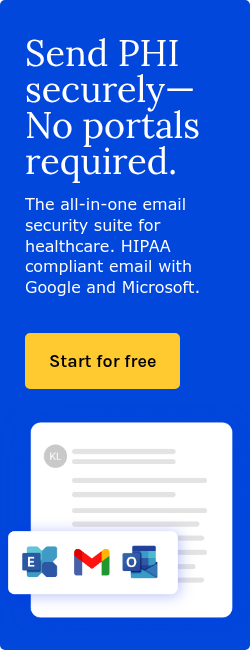
The HIPAA Omnibus Rule is a set of regulations consolidating and strengthening previous HIPAA provisions. Its primary objective is to streamline the compliance process for healthcare entities and their business associates while improving the security and privacy of patients' protected health information (PHI). The Omnibus Rule aims to coordinate and simplify HIPAA compliance regulations by enforcing stricter security protocols.
Read also: How to know if you’re a business associate
The purpose of the HIPAA Omnibus Rule
The Omnibus Rule was introduced to address the growing concerns regarding the privacy and security of patient data. It builds upon the existing HIPAA privacy, security, enforcement, and breach notification rules, expanding individuals' rights concerning their PHI. The rule allows individuals to request copies of their medical information, gain insights into how their data is shared, and exercise greater control over the use of their PHI.
Go deeper:
What is the HIPAA Privacy Rule?
What is the HIPAA Security Rule?
Key changes in the HIPAA Omnibus Rule
The HIPAA Omnibus Rule brought changes that healthcare professionals and organizations must adhere to:
Breach notification
Previously, healthcare entities were only obligated to report breaches affecting 500 or more individuals. However, under the new rule, any impermissible use or disclosure of PHI must be reported, regardless of the number of affected individuals. This change aims to increase transparency and ensure that all breaches are properly addressed.
Business associate requirements
The rule requires updates to existing business associate agreements to ensure compliance with the new requirements. Covered entities are also encouraged to enhance their review processes for measuring business associate compliance and incorporate liability protections within the contracts.
Marketing restrictions
The Omnibus Rule imposes tighter restrictions on marketing activities involving patient data to give individuals greater control over the use of their PHI. For instance, patient authorization is required if a covered entity receives compensation from a third party for promoting a product or service.
Reasonable disclosures
Facilitating the efficient exchange of student immunization records between healthcare organizations and educational institutions is important to ensure students' health and safety. The Omnibus Rule introduces reasonable disclosure, allowing covered entities to release immunization records with documented agreement from a parent or guardian.
Genetic information protection
The Genetic Information Nondiscrimination Act (GINA) of 2008 protects individuals from discrimination based on their genetic information. The Omnibus Rule incorporates GINA's provisions into HIPAA's privacy regulations, ensuring the safeguarding of genetic data and preventing any misuse or discrimination.
Research consent requirements
The Omnibus Rule simplifies the consent requirements for research participation. Under the new rule, researchers can use single consent forms to cover multiple studies, reducing the administrative burden previously associated with obtaining consent for each study separately.
Penalties
The Omnibus Rule establishes strict guidelines and penalties for HIPAA violations. Organizations found in violation may face penalties of up to $1.5 million per identical violation type per year. These penalties serve as a deterrent for reckless behavior that could compromise patient privacy and data security.
Read also: Understanding HIPAA violations and breaches
Enhancing patient choice for HIPAA compliant communication
According to a study on the implications of the HIPAA Omnibus Rule, "The Omnibus Rule expands an individual's right to receive an electronic copy of his/her PHI". The HIPAA Omnibus Rule also enhances patient autonomy by providing options for controlling how their PHI is used. Healthcare organizations must provide simple mechanisms for patients to opt out of fundraising communications and promptly respect their preferences.
FAQs
What is the primary purpose of the Omnibus Rule?
The primary purpose of the Omnibus Rule is to strengthen the security of sensitive health data, particularly in digital formats, and grant patients greater access to their medical information.
When was the Omnibus Rule passed?
The Omnibus Rule was released by the Department of Health and Human Services (HHS) on January 17, 2013, and became effective on March 26th of the same year.
How long does the Omnibus Rule protect HIPAA data?
The Omnibus Rule ensures that HIPAA protection extends for up to 50 years following the death of an individual. It also allows covered entities more flexibility in disclosing a decedent's PHI to those involved in their care and payment before their passing.
How often should healthcare organizations update their NPP?
Healthcare organizations should update their NPP whenever there are changes to HIPAA regulations or their privacy practices and at least once every three years to ensure accuracy and compliance.
How does the HIPAA Omnibus Rule affect patient access to their medical records?
The rule enhances patient rights by requiring healthcare organizations to provide electronic copies of medical records upon request, ensuring easier access and transparency.
How does the HIPAA Omnibus Rule impact the sharing of PHI for research purposes?
The rule allows sharing PHI for research purposes under certain conditions, such as obtaining patient authorization or ensuring de-identification of data to protect patient privacy.
Related: HIPAA Compliant Email: The Definitive Guide
Subscribe to Paubox Weekly
Every Friday we'll bring you the most important news from Paubox. Our aim is to make you smarter, faster.




